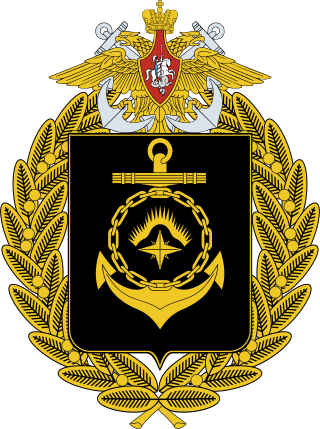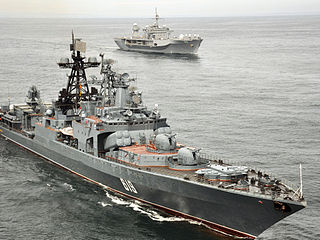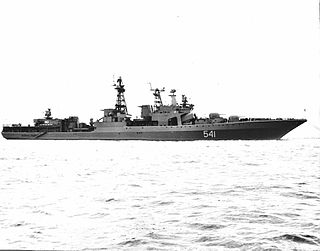
The Russian Navy is the naval arm of the Russian Armed Forces. It has existed in various forms since 1696; its present iteration was formed in January 1992 when it succeeded the Navy of the Commonwealth of Independent States.

The Northern Fleet is the fleet of the Russian Navy in the Arctic.

The Udaloy class, Soviet designation Project 1155 Fregat and Russian designation Project 11551 Fregat-M, are series of anti-submarine guided-missile destroyers built for the Soviet Navy, seven of which are currently in service with the Russian Navy. Twelve ships were built between 1980 and 1990, while the thirteenth ship built to a modified design, known as Udaloy II class, followed in 1999. They complement the Sovremenny-class destroyers in anti-aircraft and anti-surface warfare operations. The codename Udaloy comes from an archaic Russian adjective удалой, meaning daring or bold.

Pyotr Velikiy is the fourth Kirov-class battlecruiser of the Russian Navy. She was initially named Yuri Andropov after Yuri Andropov, the former General Secretary of the Communist Party, but the ship's name was changed after the fall of the Soviet Union. The Russian designation for the type is "heavy nuclear missile cruiser", but Western defense commentators have resurrected the term "battlecruiser" to describe them, as they are the largest surface "line of battle" warships in the world. Pyotr Velikiy is the flagship of the Northern Fleet.

The Russian cruiser Marshal Ustinov, is a Slava-class cruiser of the Russian Navy. The Russian name for the ship type is Raketnyy Kreyser (RKR), meaning "Missile Cruiser". The ship is named after Dmitriy Ustinov, a former Soviet Minister of Defence. Marshal Ustinov was assigned to the 43rd Missile Ship Division of the Russian Northern Fleet, whose homeport is in Severomorsk. From 2012 to 2016, the cruiser underwent a major overhaul. The vessel returned to service in 2017 and has since been deployed to the Mediterranean Sea.

Admiral Panteleyev is an Udaloy-class destroyer of the Russian Navy. She is named after Yuri Aleksandrovich Panteleyev.

Vice-Admiral Kulakov is an Udaloy-class destroyer of the Russian Navy. As of 2022, the ship was in active service. She is named after Soviet naval officer Nikolai Kulakov.

Marshal Shaposhnikov is a modernized Udaloy-class destroyer of the Russian Navy commissioned in 1985. The vessel serves in the Russian Pacific Fleet. Her namesake is Marshal Boris Shaposhnikov.

Admiral Levchenko is a Russian destroyer of the Udaloy class. The ship was laid down in 1982 and was commissioned in the Soviet Navy in 1988. After the fall of the Soviet Union the ship continued to serve in the Russian Navy with the Northern Fleet. She was named after admiral Gordey Levchenko.

Kronstadt was a Project 1134A Kresta II-class cruiser of the Soviet Navy, named for the Kronstadt naval base. The first ship of her class, the ship served during the Cold War, from 1969 to 1991. She served with the Northern Fleet, with her shakedown cruise being through the Mediterranean Sea. After colliding with a destroyer in 1975, she spent five years being repaired and modernized. She was decommissioned in 1991 before being sold for scrap two years later due to reduced naval funding and deteriorating conditions.

Admiral Chabanenko is an Udaloy II-class anti-submarine destroyer of the Russian Navy. The destroyer was laid down in 1989, during the Soviet period, and was finished by Russia 10 years later, after the dissolution of the Soviet Union. In 1999 she deployed with the Northern Fleet. The Admiral Chabanenko is the sole vessel of the Project 1155.1 design, a modified version of the Project 1155 design, also called Udaloy class. The design is also known as the Udaloy II class. The ship includes updated weapon systems like the SS-N-22 anti-ship missile and the "Zvezda" M-2 series sonar system. She is named after Admiral Andrei Chabanenko, commander of the Northern Fleet between 1952 and 1962.

Admiral Isakov was a Kresta II-class cruiser of the Soviet Navy and briefly of the Russian Navy, named for Soviet admiral Ivan Isakov. The second ship of her class, she served mostly during the Cold War from her commissioning in 1970.
Admiral Nakhimov was a Project 1134A Kresta II-class cruiser of the Soviet Navy, named for Russian naval commander Pavel Nakhimov. The third ship of her class, the ship served during the Cold War, from 1971 to 1991. She served with the Northern Fleet for the duration of her career, often operating in the Atlantic and the Mediterranean in order to show the flag. She was decommissioned in 1991 before being sold for scrap due to reduced naval funding in 1993.

Admiral Makarov was a Project 1134A Berkut A class cruiser of the Soviet Navy and briefly of the Russian Navy. The fourth ship of her class, the ship served mostly during the Cold War, from 1972 to 1992. She served with the Northern Fleet for the duration of her career, often operating in the Atlantic and the Mediterranean in order to show the flag, and was refitted between 1983 and 1985. She was decommissioned in 1992 due to deteriorating conditions which reduced naval funding prevented from being addressed before being sold for scrap in 1994.

Admiral Spiridonov was a Project 1155 Fregat Large Anti-Submarine Ship, known in the west as an Udaloy-class destroyer. The ship was named after Emil Spiridonov, a Soviet admiral who died in 1981. Launched in 1984, Admiral Spiridonov served in the Pacific Fleet with the Soviet and Russian Navies successively until being decommissioned in 2001. While in service, the vessel operated in exercises in the Sea of Japan and made good will visits to a number of Soviet allies during the latter part of the Cold War in Africa and Asia.

Severomorsk is a Udaloy-class destroyer. The ship entered service with the Soviet Navy in 1987 and after the breakup of the Soviet Union, became part of the Russian Navy.

Udaloy was a Udaloy-class destroyer of the Russian Navy.

Admiral Zakharov was a Udaloy-class destroyer of the Russian Navy. She was named after Soviet admiral Mikhail Zakharov.

Admiral Kharlamov was an Udaloy-class destroyer of the Russian Navy. It was named after admiral Nikolay Kharlamov.

Aleksandr Igorevich Peshkov is an officer of the Russian Navy. He currently holds the rank of Counter-Admiral, and is commander in chief of the Caspian Flotilla.






















